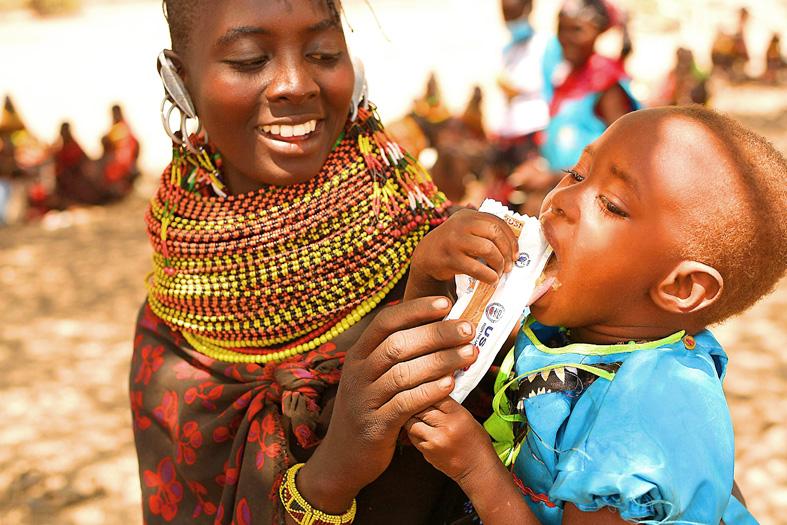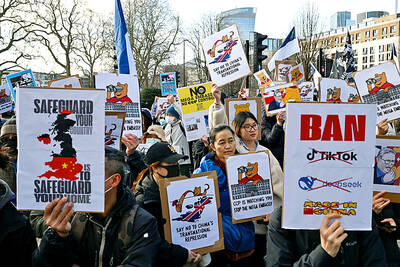Under an acacia tree in Kenya’s drought-ravaged north, malnourished infants feed on sticky mouthfuls of a nutrient-dense peanut paste long used to prevent child starvation in disasters across the globe.
This wonder food can mean the difference between life and death for a child in hard-hit Marsabit, where aid workers say young children are perishing in conditions that border on famine.
“If we ran out of these, more deaths would be recorded very soon,” James Jarso of aid group World Vision said of the sachets being distributed by charity workers in the parched and isolated village of Purapul.

Photo: AFP
However, just as 1.7 million children face starvation in the drought-stricken Horn of Africa, the cost of these life-saving supplements is skyrocketing, because of another crisis unfolding thousands of miles away.
The conflict in Ukraine is making ready-to-use therapeutic food (RUTF) more expensive to manufacture and procure, said UNICEF, which buys almost 80 percent of the world’s supply.
Ukraine is a major exporter of sunflower oil, wheat and other grains. The war has affected the price and availability of staple foods, driven up fuel prices and disrupted supply chains already off-kilter due to the COVID-19 pandemic.
A knock-on effect has been higher prices for powdered milk, vegetable oils and peanuts — all key ingredients in RUTF, said Christiane Rudert, a nutrition adviser for UNICEF for southern and eastern Africa.
Even the materials used to make RUTF packaging have become scarcer and costlier, she said.
UNICEF, which purchases about 49,000 tonnes of RUTF every year, is starting to feel the pinch.
“The cost has definitely gone up already, which affects our orders,” Rudert said.
French company Nutriset said it raised the cost of its leading RUTF product “Plumpy’Nut” twice in the past year, including a 13 percent hike in May.
It could not attribute this directly to Ukraine, but a confluence of factors, including the war, but also the pandemic, higher shipping costs and environmental disasters, Nutriset said in a statement.
Overall, the price of “Plumpy’Nut” — which reached 9.7 million children last year — had risen 23 percent since May last year, it said.
UNICEF forecasts that by November, prices for RUTF would have risen 16 percent from pre-war levels.
Russia’s invasion has also raised fuel prices, making it costlier to deliver RUTF to where it is needed.
The timing could not be worse. More than 1.7 million children in Kenya, Ethiopia and Somalia are suffering the most lethal form of malnutrition, as the Horn of Africa experiences its worst drought in generations.
The rising cost of RUTF means treating those children “will cost US$12 million more than it would have cost before Ukraine,” Rudert said.
It is money that is sorely lacking, she said, with donations to address the hunger crisis in the Horn falling well short of need.
“This product ... is literally what saves children’s lives when they have already reached that really severe form of malnutrition,” Rudert said.
“It’s not just peanuts and milk and sugar and oil... it’s therapeutic,” she added.
Invented a quarter of a century ago, RUTF proved revolutionary in treating severe wasting, a deadly condition where underfed children are too thin for their height.
A single sachet of RUTF delivers 500 calories, and essential vitamins and minerals.
Eaten directly from the packet, RUTF helps malnourished children quickly regain weight and energy, and requires no refrigeration or preparation by a healthcare worker.
This is essential in remote and impoverished regions like northern Kenya, where clean water and health workers are in short supply. On a twice-monthly visit to Purapul, government doctor Mohamed Amin said most women and children were surviving on little else than the packs of paste he prescribed.
“It has really been a challenge,” he said at a mobile health clinic, where mothers were handed two weeks’ worth of supplements to feed their children between screenings. “At least it boosts them.”
UNICEF buys enough RUTF to feed at least 3.5 million children a year.
However, at current funding levels, a 16 percent price rise could mean 600,000 miss out on this life-saving treatment, Rudert said.
Jarso said the impact of RUTF in a place like Purapul could not be overstated.
“There is no milk. There is no meat... There is no food for them. Therefore, it is life-saving,” he said.

‘SHORTSIGHTED’: Using aid as leverage is punitive, would not be regarded well among Pacific Island nations and would further open the door for China, an academic said New Zealand has suspended millions of dollars in budget funding to the Cook Islands, it said yesterday, as the relationship between the two constitutionally linked countries continues to deteriorate amid the island group’s deepening ties with China. A spokesperson for New Zealand Minister of Foreign Affairs Winston Peters said in a statement that New Zealand early this month decided to suspend payment of NZ$18.2 million (US$11 million) in core sector support funding for this year and next year as it “relies on a high trust bilateral relationship.” New Zealand and Australia have become increasingly cautious about China’s growing presence in the Pacific

Indonesia’s Mount Lewotobi Laki-Laki yesterday erupted again with giant ash and smoke plumes after forcing evacuations of villages and flight cancelations, including to and from the resort island of Bali. Several eruptions sent ash up to 5km into the sky on Tuesday evening to yesterday afternoon. An eruption on Tuesday afternoon sent thick, gray clouds 10km into the sky that expanded into a mushroom-shaped ash cloud visible as much as 150km kilometers away. The eruption alert was raised on Tuesday to the highest level and the danger zone where people are recommended to leave was expanded to 8km from the crater. Officers also

The team behind the long-awaited Vera Rubin Observatory in Chile yesterday published their first images, revealing breathtaking views of star-forming regions as well as distant galaxies. More than two decades in the making, the giant US-funded telescope sits perched at the summit of Cerro Pachon in central Chile, where dark skies and dry air provide ideal conditions for observing the cosmos. One of the debut images is a composite of 678 exposures taken over just seven hours, capturing the Trifid Nebula and the Lagoon Nebula — both several thousand light-years from Earth — glowing in vivid pinks against orange-red backdrops. The new image

ESPIONAGE: The British government’s decision on the proposed embassy hinges on the security of underground data cables, a former diplomat has said A US intervention over China’s proposed new embassy in London has thrown a potential resolution “up in the air,” campaigners have said, amid concerns over the site’s proximity to a sensitive hub of critical communication cables. The furor over a new “super-embassy” on the edge of London’s financial district was reignited last week when the White House said it was “deeply concerned” over potential Chinese access to “the sensitive communications of one of our closest allies.” The Dutch parliament has also raised concerns about Beijing’s ideal location of Royal Mint Court, on the edge of the City of London, which has so